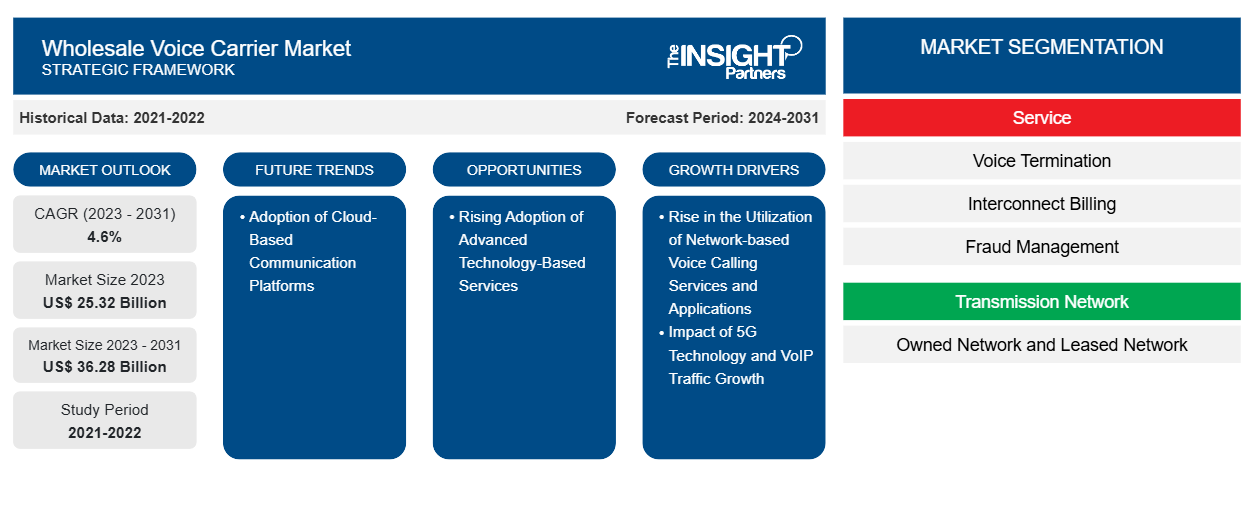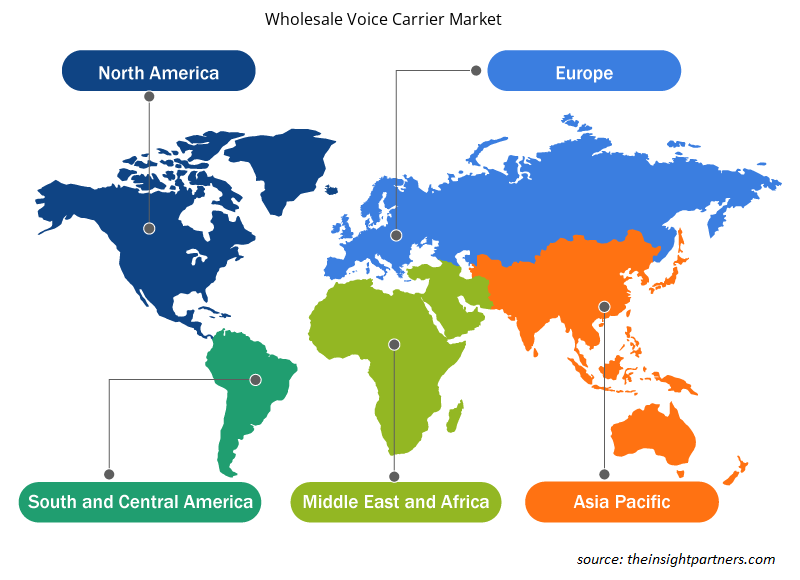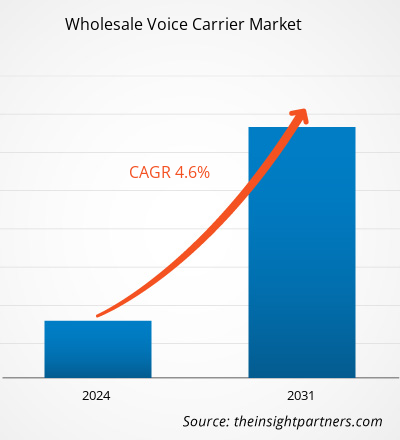The wholesale voice carrier market size is projected to reach US$ 36.28 billion by 2031 from US$ 25.32 billion in 2023. The market is expected to register a CAGR of 4.6% during 2023–2031. The adoption of cloud-based communication platforms is likely to remain a key trend in the market.
Wholesale Voice Carrier Market Analysis
The wholesale voice carrier market is an essential component of the telecommunications sector, connecting service providers and facilitating the global flow of voice traffic. Wholesale voice carriers function as intermediates, allowing voice calls to be routed efficiently between multiple telecommunications networks. Wholesale voice carriers specialize in the wholesale voice sector, providing voice termination services to telecommunication service providers such as mobile operators, fixed-line operators, and other voice providers. These carriers build enormous networks and links with operators around the world, allowing them to efficiently handle large amounts of voice traffic. International telecommunications wholesale voice providers play an important role in integrating dissimilar networks and providing smooth communication across borders.
Wholesale Voice Carrier Market Overview
The growing demand for trustworthy and cutting-edge communication solutions across a variety of end-use industries would most likely assist in the expansion of the international wholesale voice carrier market. Furthermore, as more organizations embrace globalization, the telecommunications network sector has grown substantially. International business calling solutions are rapidly developing as communication with overseas investors, contractors, and clients has become more convenient and efficient. Voice carrier services are also becoming more popular as communication and logistical network advancements accelerate.
Customize This Report To Suit Your Requirement
You will get customization on any report - free of charge - including parts of this report, or country-level analysis, Excel Data pack, as well as avail great offers and discounts for start-ups & universities
Wholesale Voice Carrier Market: Strategic Insights

- Get Top Key Market Trends of this report.This FREE sample will include data analysis, ranging from market trends to estimates and forecasts.
You will get customization on any report - free of charge - including parts of this report, or country-level analysis, Excel Data pack, as well as avail great offers and discounts for start-ups & universities
Wholesale Voice Carrier Market: Strategic Insights

- Get Top Key Market Trends of this report.This FREE sample will include data analysis, ranging from market trends to estimates and forecasts.
Wholesale Voice Carrier Market Drivers and Opportunities
Rise in the Utilization of Network-based Voice Calling Services and Applications to Favor Market
The increase in the use of network-based voice calling services and applications has considerably aided the expansion of the international wholesale voice carriers industry. Network-based voice calling services and apps, such as Voice over IP (VoIP) and mobile applications, are extremely popular due to their low cost, ease, and flexibility. Wholesale voice carriers play an important role in easing the flow of voice traffic between various networks, including traditional telephony and IP networks. As the demand for network-based phone calling services grows, wholesale carriers' ability to deliver reliable and effective voice termination services becomes increasingly important. First and foremost, the expansion of VoIP services has been a primary driver of the wholesale voice carrier business. VoIP permits voice communication to be transmitted over IP networks rather than traditional telephone networks. This technology has transformed voice communication, offering affordable and feature-rich alternatives to traditional telephony services. Wholesale voice providers allow VoIP service providers to link their networks to other domestic and international networks, resulting in seamless communication and worldwide connectivity. The increased use of VoIP services has resulted in a considerable demand for wholesale voice carrier services to facilitate the transmission of VoIP traffic across networks.
Furthermore, network-based voice calling services and applications frequently demand dependable, high-quality voice termination services to provide optimal call quality and connectivity. Wholesale voice carriers specialize in efficiently routing voice traffic, optimizing call quality, and implementing redundancy measures to prevent service outages. Their experience handling high volumes of speech traffic, as well as their resilient infrastructure, make them excellent partners for network-based voice calling services and apps, which drives wholesale voice carriers' market growth.
Rising Adoption of Advanced Technology-Based Services
Telecommunication companies are indeed transitioning away from traditional voice and data services towards wholesale voice carrier services, driven by the increasing need for advanced technology-driven services like cloud communication and IoT. This shift is influenced by several factors, including the rise of IoT as a substantial contributor to telco revenues, the impact of over-the-top (OTT) options on traditional telco services, and the ongoing shift from voice to data. The conventional wholesale voice industry is steadily decreasing as a result of the rapid growth of OTT services and VoIP services like Facebook Messenger, WhatsApp, and Skype. Telecommunication companies are shifting towards wholesale voice carrier services, which are highly profitable, as the OTTs' portion of traditional telco services is predicted to rise significantly. Telecommunication companies are seeking out fresh chances and examples of IoT in the telecom industry to expand their range of services by utilizing their distinct assets, such as expanded communication networks and cloud computing, to track asset movements. VoIP technologies allow businesses to use one network for both voice and data, cutting down on infrastructure expenses and quickly recovering after outages.
Wholesale Voice Carrier Market Report Segmentation Analysis
Key segments that contributed to the derivation of the wholesale voice carrier market analysis are service, transmission network, and technology.
- Based on service, the market is segmented into voice termination, interconnect billing, and fraud management. The voice termination segment held a significant market share in 2023.
- In terms of transmission network, the market is divided into owned network and leased network. The leased network segment held a substantial share of the market in 2023.
- Based on Technology, the market is segmented into VoIP and traditional switching. The VoIP segment held a significant market share in 2023.
Wholesale Voice Carrier Market Share Analysis by Geography
The geographic scope of the wholesale voice carrier market report is mainly divided into five regions: North America, Asia Pacific, Europe, Middle East & Africa, and South & Central America.
Significant growth in both economy and urbanization in the Asia Pacific region has led to a sharp increase in telecommunications activities. The region's significant population, growing middle class, and rising use of mobile and internet technologies have driven this growth. The increasing need for wholesale voice carrier services, driven by the growing demand for voice communication services nationally and globally, has resulted in the region's market domination. Nations like China, India, Japan, and South Korea have experienced notable progress in their telecommunications infrastructure and services. These markets experience a large amount of voice calls and are used by a variety of industries that heavily depend on voice services. Wholesale voice carriers in the area meet the needs of these markets by offering effective voice termination services and meeting the connectivity needs of service providers. Countries such as China and India have made important pledges to enhance their telecommunications networks, boost internet connectivity, and encourage digital transformation. These investments have established a solid base for the expansion of wholesale voice carrier services, allowing the region to meet the rising need for voice communication and connectivity.
Wholesale Voice Carrier Market Regional Insights
The regional trends and factors influencing the Wholesale Voice Carrier Market throughout the forecast period have been thoroughly explained by the analysts at Insight Partners. This section also discusses Wholesale Voice Carrier Market segments and geography across North America, Europe, Asia Pacific, Middle East and Africa, and South and Central America.

- Get the Regional Specific Data for Wholesale Voice Carrier Market
Wholesale Voice Carrier Market Report Scope
| Report Attribute | Details |
|---|---|
| Market size in 2023 | US$ 25.32 Billion |
| Market Size by 2031 | US$ 36.28 Billion |
| Global CAGR (2023 - 2031) | 4.6% |
| Historical Data | 2021-2022 |
| Forecast period | 2024-2031 |
| Segments Covered |
By Service
|
| Regions and Countries Covered | North America
|
| Market leaders and key company profiles |
Wholesale Voice Carrier Market Players Density: Understanding Its Impact on Business Dynamics
The Wholesale Voice Carrier Market is growing rapidly, driven by increasing end-user demand due to factors such as evolving consumer preferences, technological advancements, and greater awareness of the product's benefits. As demand rises, businesses are expanding their offerings, innovating to meet consumer needs, and capitalizing on emerging trends, which further fuels market growth.
Market players density refers to the distribution of firms or companies operating within a particular market or industry. It indicates how many competitors (market players) are present in a given market space relative to its size or total market value.
Major Companies operating in the Wholesale Voice Carrier Market are:
- AT&T Inc.
- BICS SA/NA
- BT Group
- DEUTSCHE TELEKOM AG
- IDT Corporation
- Tata Communication
Disclaimer: The companies listed above are not ranked in any particular order.

- Get the Wholesale Voice Carrier Market top key players overview
Wholesale Voice Carrier Market News and Recent Developments
The wholesale voice carrier market is evaluated by gathering qualitative and quantitative data post primary and secondary research, which includes important corporate publications, association data, and databases. A few of the developments in the wholesale voice carrier market are listed below:
- Global systems integrator and sustainable telecoms transformation partner Odine is pleased to announce that Xicomm will migrate and evolve their international voice services growth plan on Odine Nebula, their cloud-based international voice management solution.
(Source: Odine, Press Release, March 2023)
- Swedish telecom operator Tele2 and Deutsche Telekom Global Carrier, the wholesale division of Deutsche Telekom, have signed a partnership agreement covering international Voice activities of Tele2 Group. Tele2 has selected Deutsche Telekom Global Carrier as a partner based on its long-standing industry experience, high-quality standards, global footprint for direct termination, and best-in-class fraud management solution.
(Source: Deutsche Telekom AG, Press Release, August 2023)
Wholesale Voice Carrier Market Report Coverage and Deliverables
The “Wholesale Voice Carrier Market Size and Forecast (2021–2031)” report provides a detailed analysis of the market covering below areas:
- Wholesale voice carrier market size and forecast at global, regional, and country levels for all the key market segments covered under the scope
- Wholesale voice carrier market trends as well as market dynamics such as drivers, restraints, and key opportunities
- Detailed PEST/Porter’s Five Forces and SWOT analysis
- Wholesale voice carrier market analysis covering key market trends, global and regional framework, major players, regulations, and recent market developments
- Industry landscape and competition analysis covering market concentration, heat map analysis, prominent players, and recent developments for the wholesale voice carrier market
- Detailed company profiles
Frequently Asked Questions
What are the driving factors impacting the wholesale voice carrier market?
The rise in the utilization of network-based voice calling services and applications and the impact of 5G technology and VoIP traffic growth are driving the market.
What are the future trends of the wholesale voice carrier market?
The adoption of cloud-based communication platforms is a key trend in the market.
Which are the leading players operating in the wholesale voice carrier market?
AT&T Inc., BICS SA/NA, BT Group, DEUTSCHE TELEKOM AG, IDT Corporation, Tata Communication, TELEFONICA S.A., Lumen Technologies, VERIZON COMMUNICATIONS, INC., and ORANGE S.A. are major players in the market.
What would be the estimated value of the wholesale voice carrier market by 2031?
The market is expected to reach a value of US$ 36.28 billion by 2031.
What is the expected CAGR of the wholesale voice carrier market?
The market is anticipated to record a CAGR of 4.6% during 2023–2031.
- Historical Analysis (2 Years), Base Year, Forecast (7 Years) with CAGR
- PEST and SWOT Analysis
- Market Size Value / Volume - Global, Regional, Country
- Industry and Competitive Landscape
- Excel Dataset
- Parking Meter Apps Market
- eSIM Market
- Advanced Distributed Management System Market
- Online Exam Proctoring Market
- Electronic Data Interchange Market
- Barcode Software Market
- Maritime Analytics Market
- Cloud Manufacturing Execution System (MES) Market
- Robotic Process Automation Market
- Digital Signature Market
Testimonials
Reason to Buy
- Informed Decision-Making
- Understanding Market Dynamics
- Competitive Analysis
- Identifying Emerging Markets
- Customer Insights
- Market Forecasts
- Risk Mitigation
- Boosting Operational Efficiency
- Strategic Planning
- Investment Justification
- Tracking Industry Innovations
- Aligning with Regulatory Trends
Yes! We provide a free sample of the report, which includes Report Scope (Table of Contents), report structure, and selected insights to help you assess the value of the full report. Please click on the "Download Sample" button or contact us to receive your copy.
Absolutely — analyst assistance is part of the package. You can connect with our analyst post-purchase to clarify report insights, methodology or discuss how the findings apply to your business needs.
Once your order is successfully placed, you will receive a confirmation email along with your invoice.
• For published reports: You’ll receive access to the report within 4–6 working hours via a secured email sent to your email.
• For upcoming reports: Your order will be recorded as a pre-booking. Our team will share the estimated release date and keep you informed of any updates. As soon as the report is published, it will be delivered to your registered email.
We offer customization options to align the report with your specific objectives. Whether you need deeper insights into a particular region, industry segment, competitor analysis, or data cut, our research team can tailor the report accordingly. Please share your requirements with us, and we’ll be happy to provide a customized proposal or scope.
The report is available in either PDF format or as an Excel dataset, depending on the license you choose.
The PDF version provides the full analysis and visuals in a ready-to-read format. The Excel dataset includes all underlying data tables for easy manipulation and further analysis.
Please review the license options at checkout or contact us to confirm which formats are included with your purchase.
Our payment process is fully secure and PCI-DSS compliant.
We use trusted and encrypted payment gateways to ensure that all transactions are protected with industry-standard SSL encryption. Your payment details are never stored on our servers and are handled securely by certified third-party processors.
You can make your purchase with confidence, knowing your personal and financial information is safe with us.
Yes, we do offer special pricing for bulk purchases.
If you're interested in purchasing multiple reports, we’re happy to provide a customized bundle offer or volume-based discount tailored to your needs. Please contact our sales team with the list of reports you’re considering, and we’ll share a personalized quote.
Yes, absolutely.
Our team is available to help you make an informed decision. Whether you have questions about the report’s scope, methodology, customization options, or which license suits you best, we’re here to assist. Please reach out to us at sales@theinsightpartners.com, and one of our representatives will get in touch promptly.
Yes, a billing invoice will be automatically generated and sent to your registered email upon successful completion of your purchase.
If you need the invoice in a specific format or require additional details (such as company name, GST, or VAT information), feel free to contact us, and we’ll be happy to assist.
Yes, certainly.
If you encounter any difficulties accessing or receiving your report, our support team is ready to assist you. Simply reach out to us via email or live chat with your order information, and we’ll ensure the issue is resolved quickly so you can access your report without interruption.





















 Get Free Sample For
Get Free Sample For